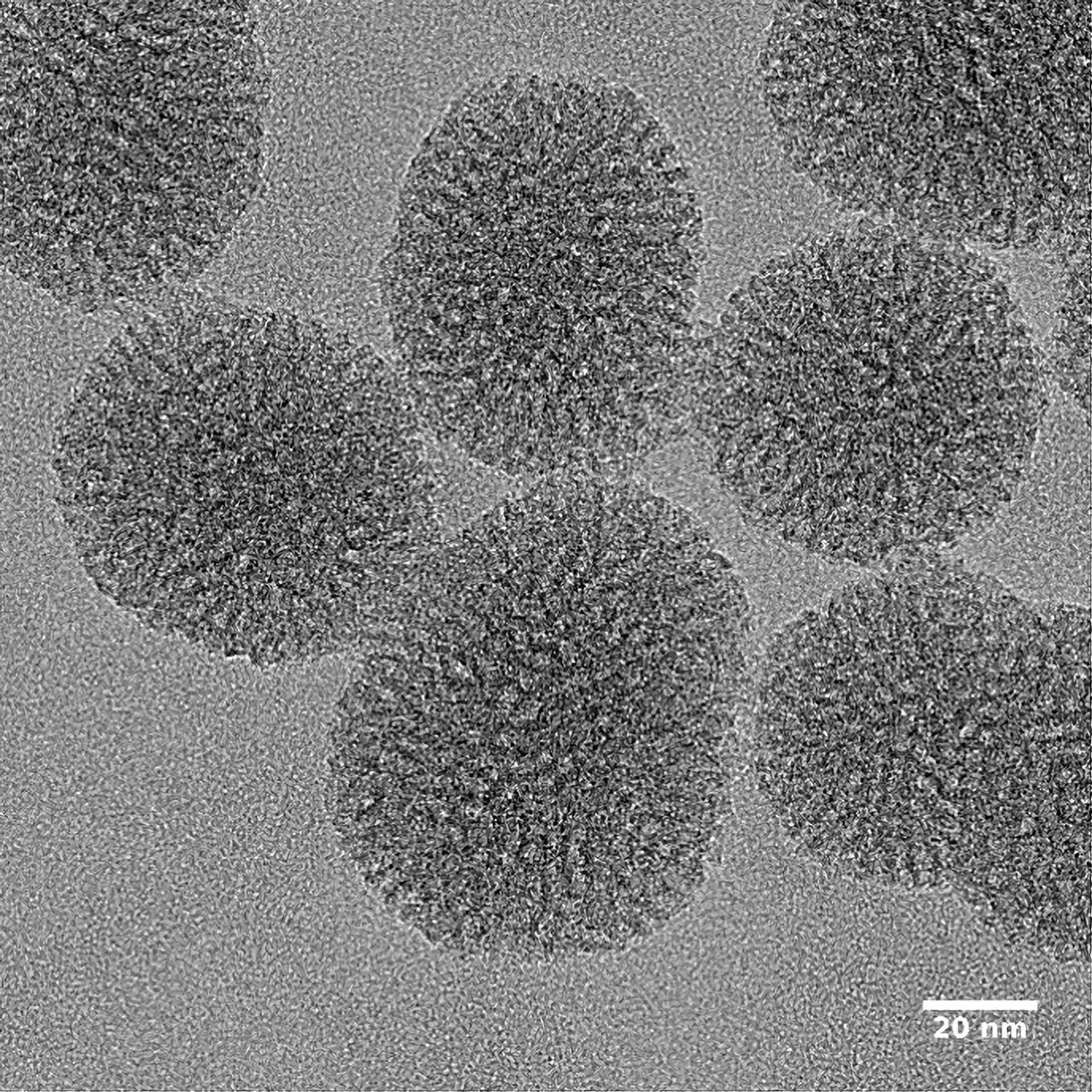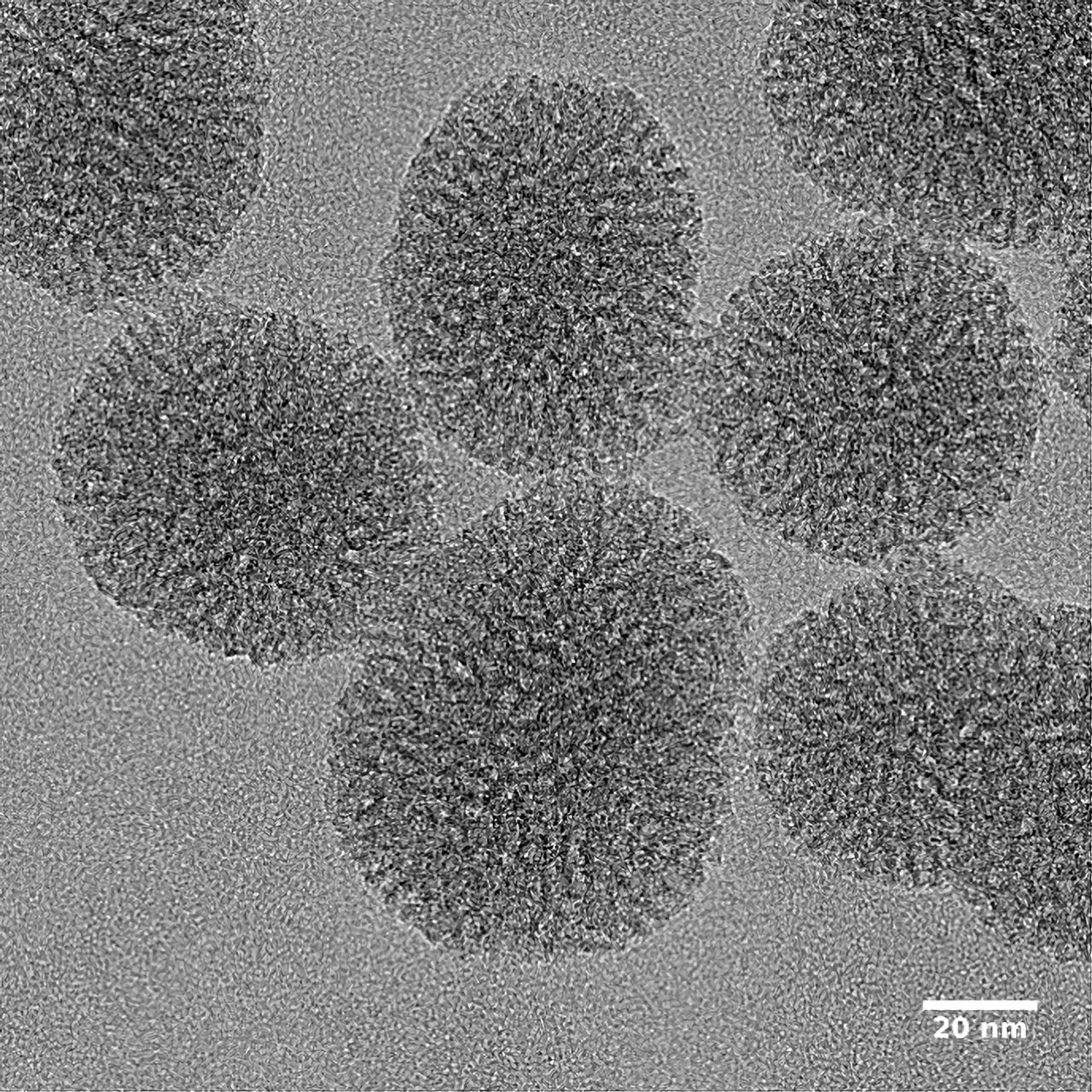
This electron micrograph paperwork the porous nature of the silica nanoparticles. These pores are giant sufficient to permit entrance of numerous NSA molecules. Right here, they’re protected till being taken up by the immune cells. At this level NSA is launched and may cease the inflammatory processes. Credit score: UNIGE – Carole Bourquin
A workforce from UNIGE and LMU developed a transport nanoparticle to make an anti-inflammatory drug rather more efficient and fewer poisonous.
How can a drug be delivered precisely the place it’s wanted, whereas limiting the chance of unwanted effects? The usage of nanoparticles to encapsulate a drug to guard it and the physique till it reaches its level of motion is being more and more studied. Nonetheless, this requires figuring out the proper nanoparticle for every drug in accordance with a collection of exact parameters. A workforce from the College of Geneva (UNIGE) and the Ludwig Maximilians Universität München (LMU) has succeeded in creating a completely biodegradable nanoparticle able to delivering a brand new anti-inflammatory drug straight into macrophages – the cells the place uncontrolled inflammatory reactions are triggered – guaranteeing its effectiveness. As well as, the scientists used an in vitro screening methodology, thus limiting the necessity for animal testing. These outcomes, lately revealed within the Journal of Managed Launch, open the way in which to a particularly {powerful} and focused anti-inflammatory therapy.
Irritation is an important physiological response of the physique to defend itself towards pathogens equivalent to micro organism. It could possibly nonetheless change into problematic when it turns right into a continual situation, equivalent to in cancers, autoimmune illnesses or sure viral infections. Many therapies exist already, however their motion is usually not very focused, excessive doses are required and deleterious unwanted effects are frequent. Macrophages, giant immune cells whose pure perform is to absorbs pathogens and set off irritation to destroy them, are sometimes concerned in inflammatory illnesses. When overactivated, they set off an extreme inflammatory response that turns towards the physique as an alternative of defending it.
Necrosulfonamide (NSA) is a brand new molecule that inhibits the discharge of a number of necessary pro-inflammatory mediators, due to this fact constituting a promising advance to scale back sure forms of irritation. Nonetheless, being extraordinarily hydrophobic in nature, it travels poorly within the bloodstream and will goal many cell varieties, triggering doubtlessly poisonous results.
‘‘Because of this this molecule just isn’t but out there as a drug,» says Gaby Palmer, a professor within the Division of Medication and the Geneva Centre for Irritation Analysis on the UNIGE College of Medication, who codirected the examine. «Utilizing a nanoparticle as a transport vessel would circumvent these shortcomings by delivering the drug straight into macrophages to fight inflammatory overactivation within the place the place it begins.’’
Three nanoparticles underneath the microscope
The scientists examined completely different porous nanoparticles, with the principle standards being a discount in toxicity and within the required dosage, in addition to the flexibility to launch the drug solely as soon as the nanoparticle has reached the inside of the macrophages. ‘‘We used an in vitro screening expertise which we developed a couple of years in the past on human and mouse cells. This protects time and vastly reduces the necessity to use animal fashions,’’ explains Carole Bourquin, a professor on the UNIGE’s Colleges of Science (Institute of Pharmaceutical Sciences of Western Switzerland) and Medication (Division of Anaesthesiology, Pharmacology, Intensive Care and Emergencies, Translational Analysis Centre in Oncohaematology, Geneva Centre for Irritation Analysis), who codirected this work at UNIGE. ‘‘Thus, solely essentially the most promising particles will then be examined on mice, which is a prerequisite for medical trials on people.”
Three very completely different nanoparticles that includes excessive porosity have been examined: a cyclodextrin-based nanoparticle, a substance generally utilized in cosmetics or industrial meals, a porous magnesium phosphate nanoparticle, and at last a porous silica nanoparticle. ‘‘The primary was much less passable in cell uptake habits, whereas the second proved to be counterproductive: it triggered the discharge of pro-inflammatory mediators, stimulating the inflammatory response as an alternative of combating it,’’ says Bart Boersma, a doctoral pupil in Carole Bourquin’s laboratory and first creator of this examine.
‘‘The porous silica nanoparticle, however, met all the standards: it was absolutely biodegradable, of the proper dimension to be swallowed by macrophages, and was capable of take in the drug into its quite a few pores with out releasing it too early. The anti-inflammatory impact was outstanding.” The workforce then replicated their exams by coating the nanoparticles with a further layer of lipid, however with no higher profit than silica nanoparticles alone.
Tiny silica sponges
Different silica nanosponges developed by the German-Swiss workforce had already confirmed their effectiveness in transporting anti-tumor medication. ‘‘Right here, they carry a really completely different drug that inhibits the immune system,’’ says Carole Bourquin. ‘‘Mesoporous silica is more and more revealing itself as a nanoparticle of alternative within the pharmaceutical subject, as it is rather efficient, steady and non-toxic. However, every drug requires a tailored provider: the form, dimension, composition and vacation spot of the particles should be reassessed every time.” The mix of this potent anti-inflammatory drug and these mesoporous silica nanoparticles reveals a promising synergism to be additional studied by the workforce.
Reference: “Inhibition of IL-1ß launch from macrophages focused with necrosulfonamide-loaded porous nanoparticles” by Bart Boersma, Karin Möller, Lisa Wehl, Viola Puddinu, Arnaud Huard, Sébastien Fauteux-Daniel, Carole Bourquin, Gaby Palmer and Thomas Bein, 13 October 2022, Journal of Managed Launch.
DOI: 10.1016/j.jconrel.2022.09.063
Supply By https://scitechdaily.com/new-nanoparticle-to-act-at-the-heart-of-cells-for-extremely-powerful-and-targeted-anti-inflammatory-treatment/
